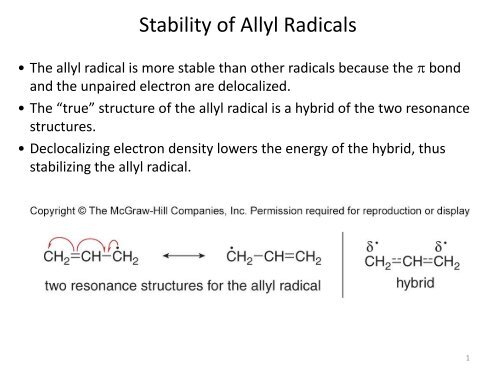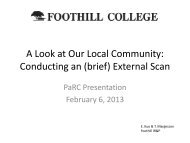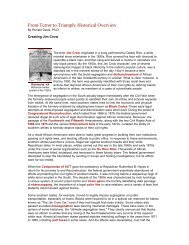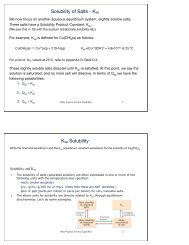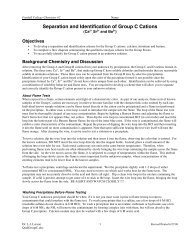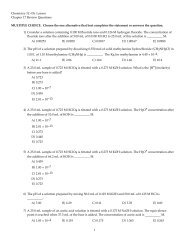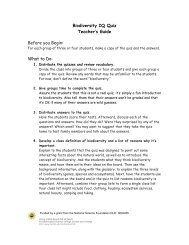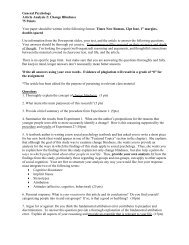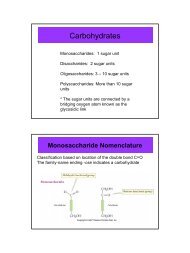Stability of Allyl Radicals
Stability of Allyl Radicals
Stability of Allyl Radicals
You also want an ePaper? Increase the reach of your titles
YUMPU automatically turns print PDFs into web optimized ePapers that Google loves.
<strong>Stability</strong> <strong>of</strong> <strong>Allyl</strong> <strong>Radicals</strong><br />
• The allyl radical is more stable than other radicals because the p bond<br />
and the unpaired electron are delocalized.<br />
• The “true” structure <strong>of</strong> the allyl radical is a hybrid <strong>of</strong> the two resonance<br />
structures.<br />
• Declocalizing electron density lowers the energy <strong>of</strong> the hybrid, thus<br />
stabilizing the allyl radical.<br />
1
<strong>Radicals</strong><br />
• A significant group <strong>of</strong> reactions involve radical intermediates.<br />
• A radical is a reactive intermediate with a single unpaired electron,<br />
formed by homolysis <strong>of</strong> a covalent bond.<br />
• A radical contains an atom that does not have an octet <strong>of</strong> electrons.<br />
• Half-headed arrows are used to show the movement <strong>of</strong> electrons in<br />
radical processes.<br />
2
Structure <strong>of</strong> <strong>Radicals</strong><br />
• Carbon radicals are classified as 1°, 2°, or 3°.<br />
• A carbon radical is sp 2 hybridized and trigonal planar, like carbocations.<br />
• The unhybridized p orbital contains the unpaired electron and extends<br />
above and below the trigonal planar carbon.<br />
3
Figure 15.1<br />
The relative stability <strong>of</strong> 1°<br />
and 2° carbon radicals<br />
<strong>Stability</strong> <strong>of</strong> <strong>Radicals</strong><br />
4
General Features <strong>of</strong> Radical Reactions<br />
• <strong>Radicals</strong> are formed from covalent bonds by adding energy in the form <strong>of</strong><br />
heat () or light (h).<br />
• Some radical reactions are carried out in the presence <strong>of</strong> a radical<br />
initiator.<br />
• Radical initiators, such as peroxides <strong>of</strong> general structure, RO–OR, contain<br />
an especially weak bond that serves as a source <strong>of</strong> radicals.<br />
• Heating a peroxide readily causes homolysis <strong>of</strong> the weak O–O bond,<br />
forming two RO• radicals.<br />
• <strong>Radicals</strong> undergo two main types <strong>of</strong> reactions—they react with bonds,<br />
and they add to p bonds.<br />
5
Reaction <strong>of</strong> a Radical X• with a C–H Bond<br />
• A radical X•, once formed, rapidly reacts with whatever is available,<br />
usually a stable or p bond.<br />
• A radical X• abstracts a hydrogen atom from a C–H bond to form H–X<br />
and a carbon radical.<br />
6
Reaction <strong>of</strong> a Radical X• with a C=C Bond<br />
• A radical X• also adds to the p bond <strong>of</strong> a carbon–carbon double bond.<br />
• In either type <strong>of</strong> radical reaction (with a or p bond) a new radical is<br />
created.<br />
7
Inhibition <strong>of</strong> <strong>Radicals</strong> by Molecular Oxygen<br />
• Occasionally, two radicals react to form a sigma bond.<br />
• An example is the reaction <strong>of</strong> a radical with oxygen (a diradical in its<br />
ground state electronic configuration).<br />
• Reaction with oxygen causes the reaction to slow down or stop, as X–O–<br />
O• radicals are not as reactive as halogen radicals.<br />
• Compounds that prevent radical reactions from occurring are called<br />
radical inhibitors or radical scavengers.<br />
8
Radical Halogenation <strong>of</strong> Alkanes<br />
• In the presence <strong>of</strong> heat or light, alkanes react with halogens to form alkyl<br />
halides by a radical substitution reaction.<br />
• Halogenation <strong>of</strong> alkanes is only useful with Cl 2 or Br 2.<br />
• Reaction with F 2 is too violent, and reaction with I 2 is too slow to be<br />
useful.<br />
• With an alkane that has more than one type <strong>of</strong> hydrogen atom, a mixture<br />
<strong>of</strong> alkyl halides may result.<br />
9
• When a single hydrogen atom on a carbon has been replaced by a<br />
halogen atom, monohalogenation has taken place.<br />
• When excess halogen is used, it is possible to replace more than one<br />
hydrogen atom on a single carbon with halogen atoms.<br />
• Monohalogenation can be achieved experimentally by adding halogen X 2<br />
to an excess <strong>of</strong> alkane.<br />
Figure 15.2<br />
Complete halogenation <strong>of</strong><br />
CH 4 using excess Cl 2<br />
Radical Halogenation <strong>of</strong> Alkanes<br />
10
Halogenation <strong>of</strong> Alkanes—Mechanism<br />
• Three facts about halogenation suggest that the mechanism involves<br />
radical, not ionic, intermediates:<br />
11
Common Steps <strong>of</strong> Radical Reactions<br />
• Radical halogenation has three distinct steps:<br />
• This type <strong>of</strong> mechanism that involves two or more repeating steps is<br />
called a chain mechanism.<br />
• The most important steps <strong>of</strong> any chain mechanism including radical<br />
halogenation are the propagation steps which lead to product formation.<br />
12
Figure 15.4<br />
Energy Diagram for Radical Propagation<br />
14
Product Mixture in Radical Chlorination<br />
• Chlorination <strong>of</strong> CH 3CH 2CH 3 affords a 1:1 mixture <strong>of</strong> CH 3CH 2CH 2Cl and<br />
(CH 3) 2CHCl.<br />
• CH 3CH 2CH 3 has six 1° hydrogens and only two 2° hydrogens, so the<br />
expected product ratio <strong>of</strong> CH 3CH 2CH 2Cl to (CH 3) 2CHCl (assuming all<br />
hydrogens are equally reactive) is 3:1.<br />
15
Radical Halogenation <strong>of</strong> Alkanes<br />
• Since the observed ratio between CH 3CH 2CH 2Cl and (CH 3) 2CHCl is 1:1, the<br />
2° C–H bonds must be more reactive than the 1° C–H bonds.<br />
• Thus, when alkanes react with Cl 2, a mixture <strong>of</strong> products results, with<br />
more product formed by cleavage <strong>of</strong> the weaker C–H bond than you<br />
would expect on statistical grounds.<br />
16
Chlorination vs Bromination<br />
• Although alkanes undergo radical substitutions with both Cl 2 and Br 2,<br />
chlorination and bromination exhibit two important differences.<br />
1. Chlorination is faster than bromination.<br />
2. Chlorination is unselective, yielding a mixture <strong>of</strong> products, but<br />
bromination is more selective, <strong>of</strong>ten yielding one major product.<br />
17
Energy <strong>of</strong> Halogenation<br />
• The differences in chlorination and bromination can be explained by<br />
considering the relative energetics <strong>of</strong> their key propagation steps.<br />
• Calculating H o using bond dissociation energies reveals that abstraction<br />
<strong>of</strong> a 1° or 2° hydrogen by Br• is endothermic.<br />
• However, it takes less energy to form the more stable 2° radical, and this<br />
difference is more important in endothermic steps.<br />
18
Energy Diagram for Endothermic Reaction—<br />
Bromination<br />
Figure 15.5<br />
• Because the rate-determining step is endothermic, the transition state<br />
resembles the products.<br />
• The more stable radical is formed faster, and <strong>of</strong>ten a single radical<br />
halogenation product predominates.<br />
19
Energy <strong>of</strong> Radical Formation<br />
• Calculating H° using bond dissociation energies for chlorination reveals<br />
that abstraction <strong>of</strong> a 1° or 2° hydrogen by Cl• is exothermic.<br />
• Since chlorination has an exothermic rate-determining step, the<br />
transition state to form both radicals resembles the same starting<br />
material, CH 3CH 2CH 3.<br />
• Thus, the relative stability <strong>of</strong> the two radicals is much less important, and<br />
both radicals are formed.<br />
20


